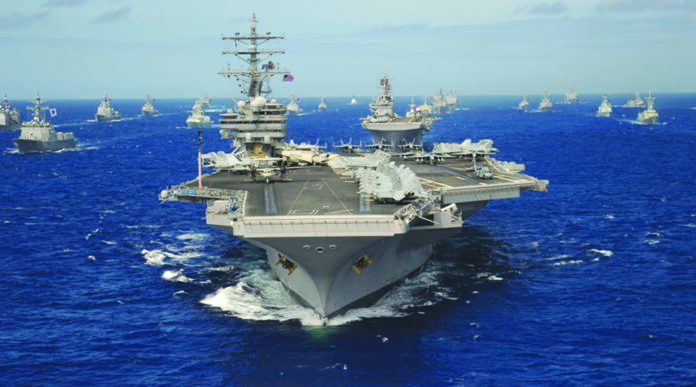The changing strategic landscape of the Indo-Pacific region, characterized by China’s growing assertiveness, has led to renewed calls for the USA to establish a formal collective defence pact in Asia. For decades, the idea of such an alliance was considered neither feasible nor necessary, primarily due to the fragmented political interests of regional actors, the complexity of historical rivalries, and the relatively stable balance of power maintained by the USA’s bilateral security arrangements. However, in recent years, China’s rapid military modernization, its increasingly aggressive posture in the South China Sea and Taiwan Strait and its broader geopolitical ambitions have significantly altered the regional power equation. In this context, the notion of a Pacific defence pact has evolved from a theoretical proposition to a strategic imperative.
China’s foreign policy under President Xi Jinping has grown more assertive, driven by a vision of national resurgence encapsulated in the slogan “the great rejuvenation of the Chinese nation.” This ambition is not merely symbolic; it manifests in tangible geopolitical strategies, including territorial claims over disputed waters, increased military incursions near Taiwan and efforts to expand Chinese influence through mechanisms such as the Belt and Road Initiative (BRI).
Beijing’s long-term goal appears to be the establishment of a regional order in which China is the preeminent power, capable of setting rules and norms to suit its strategic interests. This trajectory, if left unchecked, threatens to destabilize the existing security framework in the Indo-Pacific and could potentially provoke military conflict.
In response, several US allies and partners in the region have begun to recalibrate their defence postures. Japan has significantly increased its defence budget and revised its security policies, allowing for a more proactive military role. Australia, similarly, has intensified its military cooperation with the USA and other regional actors, notably through the AUKUS pact. South Korea, while traditionally more focused on the threat from North Korea, is increasingly attentive to the strategic challenges posed by China. Even countries in Southeast Asia, such as the Philippines and Vietnam, are seeking closer security ties with the USA and other like-minded powers to hedge against Chinese encroachment. Despite these efforts, the lack of a formal, institutionalized collective defence framework undermines the cohesion and effectiveness of regional deterrence.
The USA, as the principal guarantor of regional stability, must therefore transition from its traditional hub-and-spokes model of bilateral alliances to a multilateral approach. A Pacific defence pact, similar in structure and purpose to NATO, would offer a more unified and credible deterrent against Chinese adventurism. Such an alliance would not only enhance interoperability and strategic coordination among member states but also signal a clear, collective commitment to defending the status quo in the Indo-Pacific. The psychological impact of such a pact should not be underestimated: it would serve as a powerful message to Beijing that coercion and expansionism will be met with unified resistance.
One of the main arguments against the formation of a Pacific defence pact has been the diversity of political systems, threat perceptions and historical grievances among potential member states. However, recent developments indicate that strategic convergence is now more attainable than ever before. The Quad, a security dialogue comprising the United States, Japan, India and Australia, has evolved from a loose consultative mechanism into a more structured platform for defence cooperation. While it is not a mutual defence alliance, its existence and growing activities suggest a willingness among its members to deepen strategic alignment. Similarly, the increasing frequency of joint military exercises, intelligence sharing and defence technology transfers in the region underscores the readiness of like-minded nations to enhance their collective security.
Another critical aspect supporting the case for a Pacific defence pact is the evolving nature of warfare and security threats. Traditional concepts of territorial defence are being supplemented, and in some cases replaced, by hybrid warfare, cyber-attacks and grey-zone operations. China’s use of non-military tools such as economic coercion, disinformation campaigns and maritime militias demonstrates the need for a security architecture that goes beyond conventional military alliances. A collective defence pact would facilitate the sharing of not just military capabilities but also intelligence, cybersecurity infrastructure and early warning systems, thus enabling member states to mount a coordinated response to a broader spectrum of threats.
A Pacific defence alliance would not only bolster deterrence and stability but also reaffirm the USA’s commitment to upholding a free, open and rules-based order in the region. In the absence of such a concerted effort, the Indo-Pacific risks sliding into a period of uncertainty, rivalry and potential conflict, an outcome that no responsible power should accept.
Critics may argue that a formal alliance could provoke Beijing and accelerate an arms race in the region. While this concern is valid, it overlooks the fact that the status quo is already deteriorating. China has been expanding its military capabilities and influence regardless of US policy choices. In fact, strategic ambiguity and fragmented defence arrangements are more likely to embolden China, as they create uncertainty about the consequences of its actions. A clear, rules-based framework anchored in collective defence would reduce the likelihood of miscalculation and serve as a stabilizing force in the region. It would also offer smaller states the confidence to resist coercion, thereby strengthening the overall resilience of the regional order.
Furthermore, the establishment of a Pacific defence pact would have significant implications for global security. As the Indo-Pacific becomes the primary theatre of geopolitical competition, stability in this region is increasingly vital to international trade, supply chains and economic growth. The vast majority of global maritime commerce passes through Indo-Pacific waters and any disruption, whether through conflict or coercion, would have far-reaching consequences. A robust security architecture would thus not only protect the sovereignty and interests of regional states but also uphold the global economic order.
It is also important to recognize the normative dimension of such a pact. Beyond military considerations, a Pacific alliance would reinforce the principles of international law, freedom of navigation and the peaceful resolution of disputes. These values are currently under threat from China’s efforts to reinterpret or disregard established norms. By aligning around shared principles, member states can collectively promote a vision of regional order based on openness, sovereignty and mutual respect. This normative consensus would also enhance the legitimacy of the alliance and make it more attractive to prospective members.
The time is ripe for the USA to spearhead the formation of a collective defence pact in the Indo-Pacific. The growing threat posed by China’s assertive behavior and geopolitical ambitions has rendered traditional security arrangements insufficient. While the path to establishing such a pact is fraught with political and diplomatic challenges, the strategic rationale is compelling.
A Pacific defence alliance would not only bolster deterrence and stability but also reaffirm the USA’s commitment to upholding a free, open and rules-based order in the region. In the absence of such a concerted effort, the Indo-Pacific risks sliding into a period of uncertainty, rivalry and potential conflict, an outcome that no responsible power should accept.






















